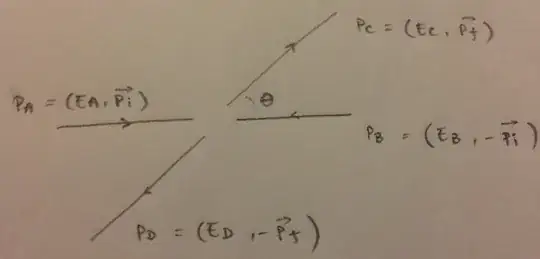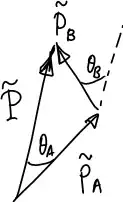I want to show for the following process that, except for the angle $\theta$, all momenta and energies are fixed by energy-momentum conservation.
 Namely:
$$p_A=\frac{1}{2\sqrt{s}}(s+m^2_A-m^2_B\space,\space 0\space,\space 0\space,\space\sqrt{\eta_i})$$
$$p_B=\frac{1}{2\sqrt{s}}(s-m^2_A+m^2_B\space,\space 0\space,\space 0\space,\space -\sqrt{\eta_i})$$
$$p_C=\frac{1}{2\sqrt{s}}(s+m^2_C-m^2_D\space,\space \sqrt{n_f}sin(\theta)\space,\space 0\space,\space\sqrt{n_f}cos(\theta))$$
$$p_D=\frac{1}{2\sqrt{s}}(s-m^2_C+m^2_D\space,\space -\sqrt{n_f}sin(\theta)\space,\space 0\space,\space-\sqrt{n_f}cos(\theta))$$
Namely:
$$p_A=\frac{1}{2\sqrt{s}}(s+m^2_A-m^2_B\space,\space 0\space,\space 0\space,\space\sqrt{\eta_i})$$
$$p_B=\frac{1}{2\sqrt{s}}(s-m^2_A+m^2_B\space,\space 0\space,\space 0\space,\space -\sqrt{\eta_i})$$
$$p_C=\frac{1}{2\sqrt{s}}(s+m^2_C-m^2_D\space,\space \sqrt{n_f}sin(\theta)\space,\space 0\space,\space\sqrt{n_f}cos(\theta))$$
$$p_D=\frac{1}{2\sqrt{s}}(s-m^2_C+m^2_D\space,\space -\sqrt{n_f}sin(\theta)\space,\space 0\space,\space-\sqrt{n_f}cos(\theta))$$
, where $\eta_i=4s|\vec{p_i}|^2$ and $\eta_f=4s|\vec{p_f}|^2$. That said, my approach was to determine the energies and 3-momenta at the center of momentum reference frame for each particle, with a fixed $s$, and check it corresponds to each one of the above, but I'm having some trouble proving that, for example, $E_A=\frac{s+m^2_A-m^2_B}{2\sqrt{s}}$. I've been playing around with $(p_A+p_B)^2=(E_A+E_B)^2=s$ but i'm failing to determine $E_A$. How should I do it?
